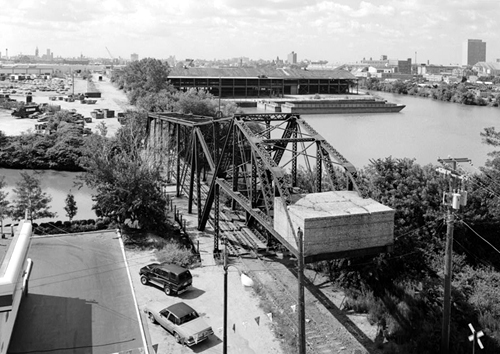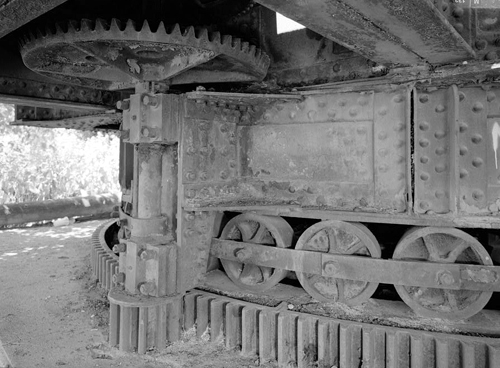Chicago, Milwaukee & St. Paul Railway Bridge No. Z-2
 |
|
Address: North Cherry St., immediately South of North Ave. (North Branch of Chicago River)
Year Built:
1901
- 1902
Architect:
Chicago, Milwaukee & St. Paul Railway
Date Designated a Chicago Landmark:
December 12, 2007
|
 The Chicago, Milwaukee & St. Paul Railway Bridge No. Z-2 is a rare asymmetrical "bobtail" swing span bridge from the late 19th century. Its significance lies not only in its design, but in the role it played in the historic development of Goose Island, carrying the only rail line to the island. In addition, the bridge once carried limited vehicular traffic, making it perhaps the only surviving bridge in Chicago that served combined modes of transportation. The bridge's superstructure is made from 210 tons of steel, with a concrete counterweight weighing 140 tons all of which rest on a circular nest of 40 wheels that support the entire weight of the bridge. When in operation an electric motor engaged the gear mechanism, forcing the span to rotate and swing towards the shoreline. The bridge owes the necessity of its existence to a canal built by William Ogden, Chicago's first mayor, who was the primary backer for its construction in the mid-1850s. The canal allowed the island to function as an industrial core for Chicago, with tanneries, grain elevators, a coal yard and steel mill. Today the bridge's operating mechanism has been disabled and since larger craft no longer use the waterway, the bridge remains locked in position. In 2009, the bridge was restored by the Chicago Department of Transportation and pedestrian and bike paths were installed on the span to connect North Avenue to Goose Island.
The Chicago, Milwaukee & St. Paul Railway Bridge No. Z-2 is a rare asymmetrical "bobtail" swing span bridge from the late 19th century. Its significance lies not only in its design, but in the role it played in the historic development of Goose Island, carrying the only rail line to the island. In addition, the bridge once carried limited vehicular traffic, making it perhaps the only surviving bridge in Chicago that served combined modes of transportation. The bridge's superstructure is made from 210 tons of steel, with a concrete counterweight weighing 140 tons all of which rest on a circular nest of 40 wheels that support the entire weight of the bridge. When in operation an electric motor engaged the gear mechanism, forcing the span to rotate and swing towards the shoreline. The bridge owes the necessity of its existence to a canal built by William Ogden, Chicago's first mayor, who was the primary backer for its construction in the mid-1850s. The canal allowed the island to function as an industrial core for Chicago, with tanneries, grain elevators, a coal yard and steel mill. Today the bridge's operating mechanism has been disabled and since larger craft no longer use the waterway, the bridge remains locked in position. In 2009, the bridge was restored by the Chicago Department of Transportation and pedestrian and bike paths were installed on the span to connect North Avenue to Goose Island.
|
|

|
|